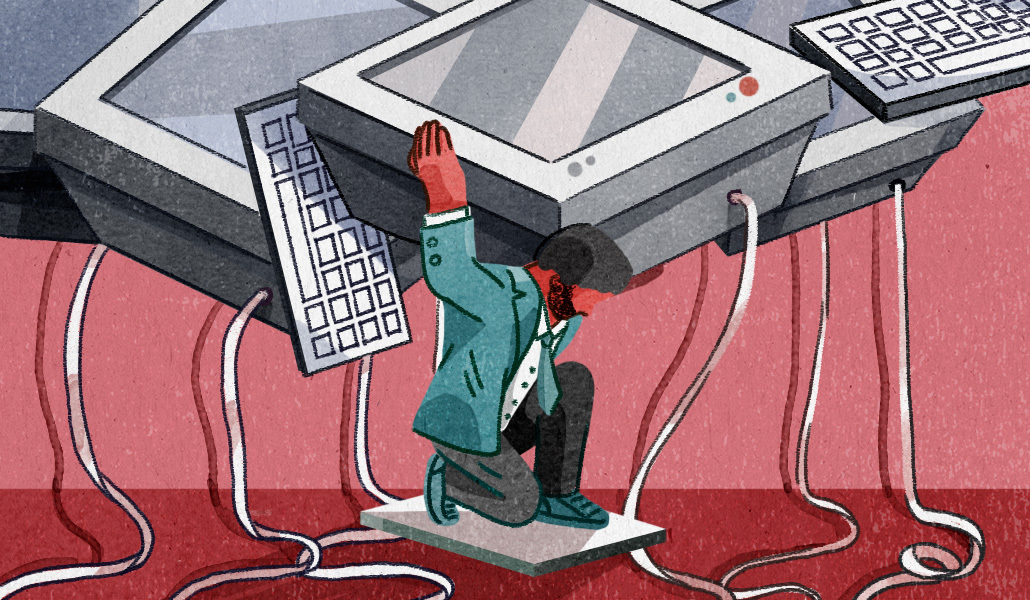RTO, team conflicts, layoffs, mental health: more tough conversations are falling on middle managers

The unpredictability of the business environment, coupled with intense pressure on productivity and ensuring hybrid team cohesion, leaves middle managers constantly on edge, trying to make sense of shifting priorities and objectives. This article is part of an editorial series that spotlights their frustrations and where they need more support. More from the series →
Being a middle manager today entails having a lot of tough conversations – perhaps more than ever.
That’s because middle managers – that vital but often unsupported link between upper management and frontline employees – are getting saddled with a host of new unpleasant tasks, from fielding complaints and requests around new return-to-office policies to mediating conflicts staff are having with other team members.
Then of course there are the age-old tasks that have always been part of a middle manager’s remit, like having to tell employees why they aren’t receiving a raise or promotion. Some are even having to shoulder the burden of delivering news about layoffs, and uneasy staff are coming to them with mental health concerns. Handling these talks thoughtfully and delicately is an art many aren’t equipped for, especially in the workplace.
“They’re really just a messenger of something that they don’t necessarily have a hand in,” said Jim Frawley, founder and CEO of Bellwether, an executive development firm.
That’s especially true when it comes to layoff discussions — whether managers are telling staff the news or having ongoing talks with those who stay. While it depends on the company, middle managers are often tasked with delivering layoff news to those losing their jobs, and are sometimes given little training beyond a script to go off of, Frawley said. And those conversations can still go many different ways.
“A middle manager is not responsible for causing the layoffs, and many middle managers when they’re trying to communicate layoffs are defensive or trying to defend something they really shouldn’t have to defend,” Frawley said.
“This is really about identifying the objective situation and co-creating some kind of solution with the people being laid off as to what their next steps are going to be,” he said. Managers should be as respectful and caring as possible when delivering the news and when helping address an exiting employee’s next steps, like by offering to write a recommendation or other help with outplacement services.
They should also emphasize how they’re continuing to support laid-off staff to those who remain, said Emily Rose McRae, senior director analyst at Gartner. Continuing conversations with remaining staff post-layoff are crucial to keep them engaged, and workload discussions should also be a priority. Managers need to “adjust expectations accordingly, and have those conversations so that you can meet realistic goals, because if the goals stay the same, but your headcount has drastically changed, you’re setting your workforce up for burnout,” McRae said.
They also need to be as transparent as possible. “A lot of organizations are really hesitant to be transparent about layoff information in general. But employees are paying attention and employees will fill in the gaps if you don’t provide information,” she said.
The organizational restructuring that follows layoffs is also tough on those left behind. And while some companies have culled middle managers themselves, others have been left shouldering extra work when colleagues haven’t been replaced. Two-thirds (64%) of employees were given additional job responsibilities in 2023, while 51% said the biggest changes to their organizations had been the restructuring of teams following layoffs and a further 42% said budget cuts had been rife, per Gallup’s latest Workplace Trends report. That’s led to increased stress, the report concluded.
Part of the issue is that managers aren’t getting supported themselves. In contrast to executive leaders who are often appointed externally, middle managers are typically promoted internally. That means they can end up a bit neglected by their own company, in terms of training and support. Nearly half (46%) of 1,600 employers and employees said their manager doesn’t know how to help them with their career development, found a report from career development and outpost placement company INTOO and research firm Workplace Intelligence, which recently surveyed 1,600 employers and employees.
“The benefit from the middle manager moving up is they understand the business better because they’ve been there, they know the culture, they’ve done the job,” said Mira Greenland, CRO of INTOO. “The downside is without additional training and support there, you’re a fabulous individual contributor –that doesn’t necessarily translate to being a fabulous leader.”
But also, they can get overlooked when it comes to necessary training. “Not only are we robbing our teams of having good leaders, we’re robbing our leaders of the joy of leadership because they’re crammed into these roles,” added Greenland. “They haven’t been given skills. They may or may not even have a good manager themselves, who is mentoring them on how to do these things.”
HR leaders have recognized managers’ growing burdens and increased investments in manager development programs, but current training methods aren’t all that helpful, according to a survey last year from Gartner including over 3,000 respondents. Just a fourth of HR leaders think investments in managers’ training programs are paying off, while 75% of managers said the training they receive is ineffective.
Mental health discussions are another key area managers are struggling to navigate. Only half of them feel very confident in having conversations about mental health with staff, according to a survey from Calm of over 4,000 global workers. They’ll need to get better at it, with 60% of workers saying their manager has a significant influence on their mental health, and as younger generations especially are more open to having these conversations in the workplace.
One way managers could improve is by more openly talking about their own mental health experiences, workers said in the survey. But when managers do reveal their personal struggles, they have to be cautious.
“What you don’t want in your effort to be open as a manager is to accidentally veer into the side of having made your problems now feel like something your employees need to respond to and support you on,” McRae said.
Some better ways for managers to talk about mental health are by reminding staff of resources if they themselves have used them, like an app or employee assistance program. That helps create some awareness and keeps the door open for discussion without “creating a burden for other people,” she said.
Ultimately, going into any real detail around your own mental health struggles as a manager is not a good idea in most cases, said Christopher Hansen, a licensed professional counselor at therapy platform Thriveworks. “That’s a really slippery slope,” Hansen said.
Additional reporting by Jessica Davies


